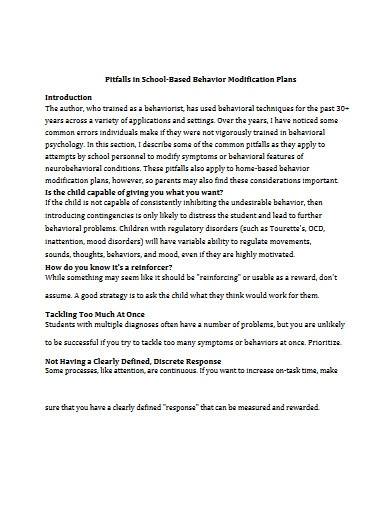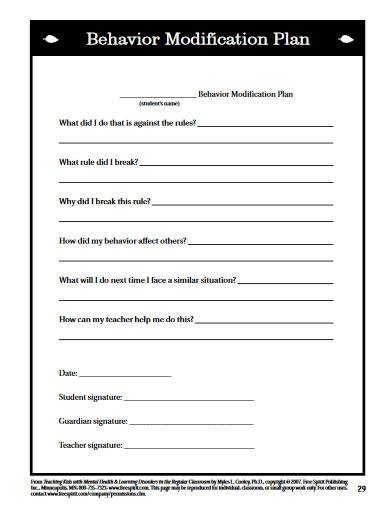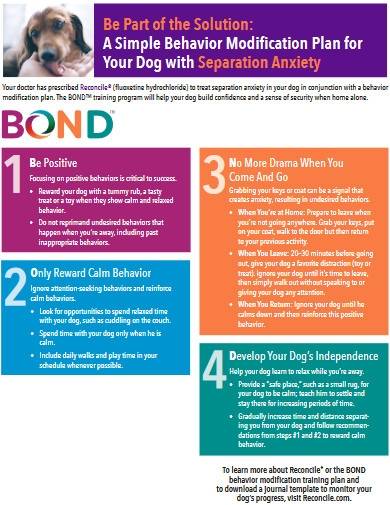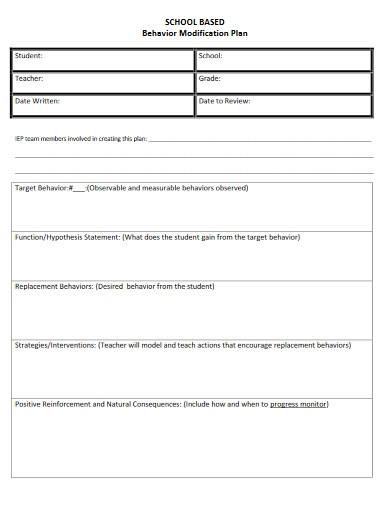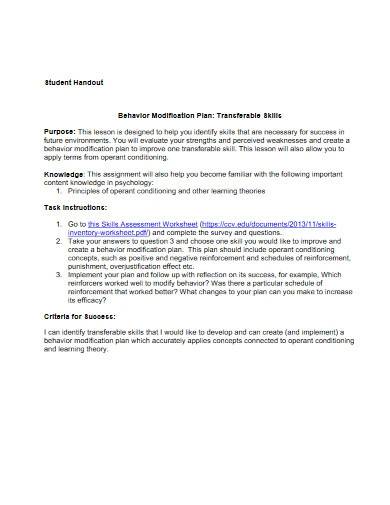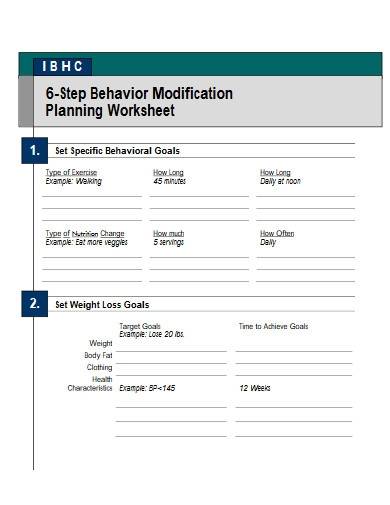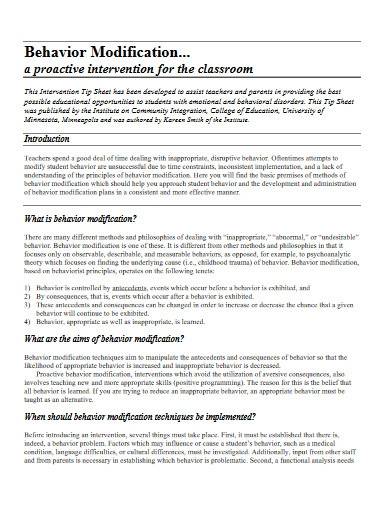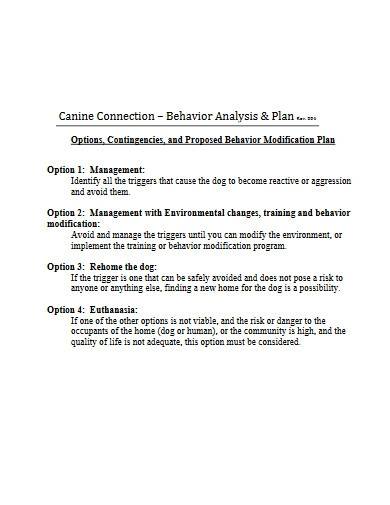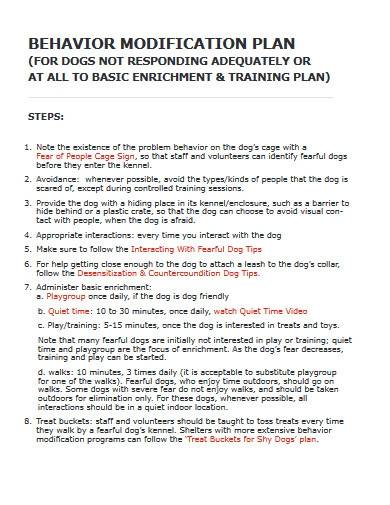Every child behaves differently. Some children tend to have some difficulty following the rules, while some tend to act aggressively towards others. Children with these behaviors can affect their future. However, with a modification plan, almost all children can be taught good behavior. A behavior modification plan boosts the positive behavior of children and reducing their negative characteristics. Thus, it is tricky to set up a perfect modification plan. Luckily, we have our downloadable sample templates that can help you. Read this entire article to know more.
FREE 10+ Behavior Modification Plan Samples
1. Behavior Modification Plan Template
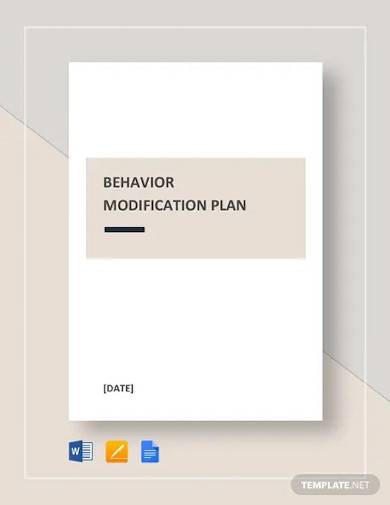
2. School-Based Behavior Modification Plan
3. Behavior Modification Plan Form
4. Dog Behavior Modification Plan
5. School-Based Behavior Modification Plan Form
6. Student Behavior Modification Plan
7. Behavior Modification Worksheet
8. Formal Behavior Modification Plan
9. Behavior Modification Analysis and Plan
10. Sample Behavior Modification Report
11. Sample Behavior Modification Plan
What Is a Behavior Modification Plan?
A behavior modification is an approach intended to improve and change a particular troublesome negative behavior. A behavior modification plan is a contract between a student and a teacher. It outlines problems of the student’s behavior and what will happen if these negative traits continue. It also records what will happen if the student begins to act positively inside the classroom. Essentially, it’s a rubric, but it outlines proper behavior rather than coursework. However, it is not only revolving in classrooms but also at home. According to Foundations Recovery Network, behavior modification is reliable and successful in treating behavioral disorders such as obsessive-compulsive disorder, separation anxiety, attention deficit hyperactivity disorder, phobias, autism, generalized anxiety disorder, disruptive behavior, and other related conditions.
How to Setup a Behavior Modification Plan?
Teachers can use behavioral modification in their classrooms to boost positive student behaviors and reduce unwanted behaviors. Since every kid is different, so is their behavioral modification approach. Behavior modification is basing the idea that a positive attitude should lead to positive consequences and that bad behavior should lead to negative results. However, a behavior modification plan does not only used inside a classroom, but it can also be applicable inside a house or a therapy center. As a teacher or a disciplinarian, here are some tips that can help you in setting up a behavior modification plan:
1. Consider the Child or Kid
The first thing you need to set up a behavioral plan is to consider the child you want to change traits. Every child is different and reacts differently. Some kids may respond better to positive approaches, and some may take better to negative reinforcement. You also have to consider the age and child’s maturity level. A growing child has a variety of behavioral modification procedures than a teenager is. Your toddler may respond to attention or a smile, while your other kid may require public recognition to make behavior more positive.
2. Consider the Behavior or Traits You Want to Change
The next step you need to take is to consider the behavior and characteristics you want to change. Identify if the behavior and attitude are easy to modify or if there is a need for several behavioral modification steps? For instance, if you’re trying to have a child brush their teeth before bed, you’ll probably need consistent positive reinforcement. But it is not as big a task as cleaning up their entire room every day, which may involve several behavioral modification techniques.
3. Consider the Best Approach
Kids respond and react differently to different behavior modification approaches. Most of them will react very well to positive strategies. Thus, some children are hard to handle and may require some negative reinforcement. That is why you have to pick the best method that suits their behavior. Also, choose a behavioral modification plan that is easy to use, so you won’t have trouble following it consistently.
4. Select the Best Behavior Modification Plan
Take notice of behavior modification plans and methodological approaches in the book. Remember, behavioral modification plans that work best are made, especially for an individual child. You should choose the best modification plan that can surely decrease or reduce negative characteristics and boost the positive ones. It should include reinforcements and punishments that can help in reducing unwanted behavior. The best way to do this is to give natural or logical consequences based on behavioral corrections that your child needs.
FAQs
What are the different types of behavior?
There are four types of human behavior based on research. These four types of behavior are the following:
- Optimistic
- Pessimistic
- Trusting
- Envious
Why is behavior modification important?
Behavior modification eliminates or stops undesirable behaviors and replace that behavior with the desired behavior. Using the principles of reinforcement, therapists help clients and parents to improve their desired behavior while at the same time constructing ways to reduce unwanted behavior.
What are the components of behavior modification?
Behavior modification uses four key components to structure and reinforces behaviors: positive and negative consequences and negative and positive reinforcement.
What are the essential principles of behavior modification?
The essential principles to teach children to act positively are the following:
- Reward your child for each correct performance
- Continuous reinforcement principle
Behavior modification methods work in various situations. It can enhance or boost positive characteristics while reducing negative traits using positive and negative reinforcement and punishments. Parents and teachers can use these modification plans to control the behavior of their children. Thus, setting up a behavior plan isn’t easy. In fact, it is quite challenging. If you don’t know how to organize your behavior plan, you can use our behavior modification plan templates. They are downloadable and easy to use. Download it now to get started!
Related Posts
FREE 9+ 30-Day Marketing Plan Samples in PDF | MS Word | Apple Pages | Google Docs
FREE 3+ Sales Team Action Plan Samples in PDF | MS Word | Apple Pages | Google Docs
Marketing Plan For Small Business Samples
FREE 7+ Fashion Business Plan Samples in PDF
FREE 10+ Sprint Planning Samples In MS Word | Google Docs | PDF
FREE 10+ Wedding Planning Samples in MS Word | Apple Pages | Powerpoint | PDF
FREE 9+ Monthly Study Planner Samples in PSD | Illustrator | InDesign | PDF
FREE 9+ Sample Curriculum Planning Templates in PDF | MS Word
FREE 10+ Teacher Development Plan Samples in MS Word | Google Docs | Apple Pages | PDF
FREE 10+ Basketball Practice Plan Samples in PDF
FREE 12+ School Business Plan Samples in PDF | MS Word | Apple Pages | Google Docs
FREE 7+ Client Strategic Plan Samples in PDF | MS Word
FREE 11+ Trucking Business Plan Templates in PDF | MS Word | Google Docs | Pages
FREE 7+ Small Hotel Business Plan Samples PDF | MS Word | Apple Pages | Google Docs
FREE 14+ Bakery Business Plans in MS Word | PDF | Google Docs | Pages

